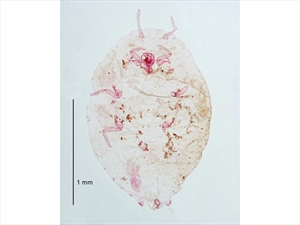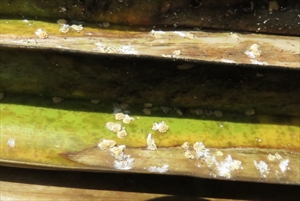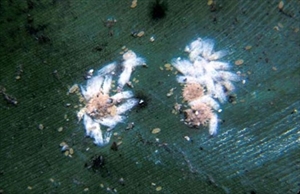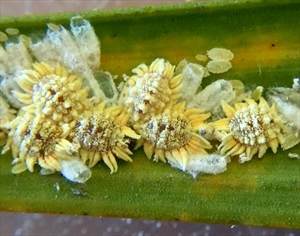Coconut mealybug, spiked mealybug
Pacific Pests, Pathogens, Weeds & Pesticides - Online edition
Pacific Pests, Pathogens, Weeds & Pesticides
Coconut mealybug (347)
Nipaecoccus nipae
Asia, Africa, North, South and Central America, Europe, Oceania. It is recorded from Fiji, Guam, Federated States of Micronesia, and Samoa.
Wide. Many fruit crops and ornamentals are attacked, including many palm species, which appear to be preferred hosts. Some of the many hosts attacked are: avocado, banana, betel nut, citrus, cocoa, coconut, guava, mango, oil palm, orchids, papaya, pineapple, and soursop.
Damage occurs in two ways: first, the adults and nymphs feed on plant sap and cause the plants to turn yellow and weaken when numbers are high; second, honeydew expelled from the mealybugs as they feed drips onto foliage which then becomes covered with sooty moulds, and these block photosynthesis. The sooty moulds further weaken plant growth.
The mealybug is 1.5-2.5 mm long, covered in beige wax - sometimes it is reddish-brown, or even yellowish-orange. Beneath the body is reddish-brown to orange (Photos 1&2). Unusually, for most mealybugs, the wax on top of the adult females is arranged in pyramid-shaped filaments, similar to those around the margins. The body contents and 'crawlers' (active first nymphs) are yellow. The males often occur in large numbers amongst the females (Photos 3-5). The males and females look similar initially, but after two moults the males develop inside a cottony cocoon and emerge as a mosquito-like insect with a pair of wings, large eyes, legs, but no mouthparts. Its task is to find females and mate.
There is no ovisac: eggs hatch producing 'crawlers' which are the most active phase. Spread occurs when crawlers move by themselves over short distances, or longer when carried by wind currents, vehicles, animals, birds, or on clothing. All stages are spread in the horticultural trade of plants or plant parts. The life cycle is 1-2 months depending on the temperature.
Generally, the mealybug is not of economic importance, but it has become important in several countries where infestations of ants have occurred, possibly new introduction. This is the situation in Fiji, Hawaii and Puerto Rico. CABI has recorded the loss of market value of ornamentals due to infestations of the coconut mealybug.
Look for the female mealybugs to see the filaments of wax on top of the body and around the margins. Look for the white cottony cocoons of the males, often more numerous than the females. Note that identification is best done after the insects are slide-mounted and examined by a specialist.
Note, Nipaecoccus floridensis has not been recorded from Fiji, and Nipaecoccus viridis (which is present in Fiji) looks quite different - much larger and very convex at maturity, with dark purple/black body contents and violet eggs and crawlers. The body wax is white and flat initially, but in very old females the outer surface often becomes yellowish.
NATURAL ENEMIES
The ladybird beetle, Cryptolaemus montrouzieri, the so-called 'mealybug destroyer', is reported to be an efficient natural enemy of the coconut mealybug. However, Waterhouse mentions that another ladybird beetle, Curinus coeruleus, was introduced into Hawaii from Mexico in 1922. Parasitoids have also proved useful. The parasitic wasp, Pseudaphycus utilis, was introduced into Hawaii and Puerto Rico, and was successful in controlling the mealybug biologically. It is important to know that such wasps are very sensitive to pesticides, and if pesticides are used against the mealybug, the right kind must be chosen to do the least harm.
It is also important to note that ants may need to be removed if the natural enemies are to be effective in controlling mealybug populations. Ants are attracted to scale insects and mealybugs that produce honeydew, and defend them from natural enemies (Photo 6).
CULTURAL CONTROL
- Prune infested stems, branches and fruits and burn them. It is especially important to do this for nursery stock before it is planted in the field.
- Alternatively, hose the plants with water if the infestation is small.
- Apply mulch, manure or synthetic fertilizers to assist plant vigour.
- Destroy ant nests with boiling water, without damaging the plants infested with the mealybug. If the ants are removed, parasitoids and predators will bring about natural control of the scale insect.
- Hot water (49°C for 12 minutes) has been used to kill mealybugs before export.
- For trees, prune low branches and remove weeds to stop ants reaching leaves and fruits.
CHEMICAL CONTROL
Use horticultural oil (made from petroleum), white oil (made from vegetable oil), or soap solution on plants infested with mealybugs (see Fact Sheet no. 56).
- White oil:
- 3 tablespoons (1/3 cup) cooking oil in 4 litres water
- ½ teaspoon pure hand soap, not detergent
- Shake well and use.
- Soap:
- Use soap (pure soap, not detergent):
- 5 tablespoons of soap in 4 litres water.
- Commercial horticultural oil can also be used. White oil, soap and horticultural oil sprays work by blocking the breathing holes of insects causing suffocation and death. Spray the undersides of leaves; the oils must contact the insects. A second application of soap or oils may be necessary after 3-4 weeks.
- The addition of malathion is useful against scales insects, but it is likely to kill natural enemies. Malathion should be avoided, if possible.
- Use synthetic pyrethroid insecticides; they are likely to be effective against the crawlers - crawlers are the active nymphs that spread infestations, but they are difficult to see as they are so small. Synthetic pyrethroids are likely to kill natural enemies. They should be avoided, if possible, but may be useful against colonies of ants, especially if the ant species is ground nesting.
____________________
When using a pesticide, always wear protective clothing and follow the instructions on the product label, such as dosage, timing of application, and pre-harvest interval. Recommendations will vary with the crop and system of cultivation. Expert advice on the most appropriate pesticides to use should always be sought from local agricultural authorities.
AUTHOR Grahame Jackson
Information from CABI (2016) Nipaecoccus nipae (spiked mealybug) Crop Protection Compendium. (https://www.cabi.org/cpc/datasheet/36334); and from Nipaecoccus nipae (Maskell). Featured Creatures. Entomology & Nematology. UF/IFAS, University of Florida. (http://entnemdept.ufl.edu/creatures/orn/mealybug/coconut_mealybug.htm). Photo 1 Gillian Watson PestNet. (http://www.pestnet.org/SummariesofMessages/Crops/Fruitsnuts/Guava/Nipaecoccusnipae,mealybug,guava,Kosrae,FSM.aspx). Photo 2 Rhode BE & Crosby TK (2013) Coconut Mealy Bug (Nipaecoccus nipae): PaDIL - (http://www.padil.gov.au). Photo 3 Randy Thaman USP Fiji. Photo 4 United States National Collection of Scale Insects Photographs, USDA Agricultural Research Service, Bugwood.org. Photo 5 Mani Mua, SPC, Sigatoka Research Station, Fiji.
Produced with support from the Australian Centre for International Agricultural Research under project PC/2010/090: Strengthening integrated crop management research in the Pacific Islands in support of sustainable intensification of high-value crop production, implemented by the University of Queensland and the Secretariat of the Pacific Community.









